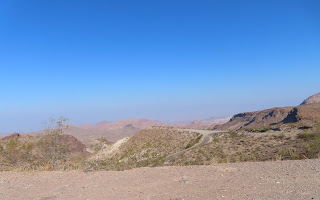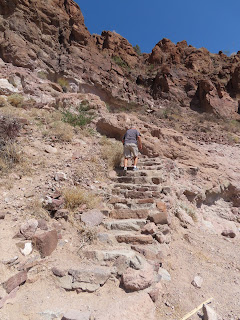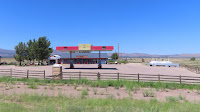Charlie & I, along with Erick & Linda took an early morning Drive to Oatman.
Our
Wagonmaster asked “What is the attraction in Oatman?” Donkies? Burros?
Yes, that is one reason I want to go there! Plus, on the ride up, I found a burro crossing sign! Another one to add to my collection!
We found these guys on the road to Oatman, they have a long ways to go to make it into town! The road to Oatman from Kingman is very narrow with several sharp hairpin curves. That was one of the reasons we wanted to travel there from Kingman. It’s about 30 miles closer from Needles, the road from there is not nearly as steep or sharp! We saw many signs for “No vehicles over forty feet in length are allowed on this road”.
The road is treacherous and there are not many modern rest stops. So, drive carefully and take advantage of the facilities when you find them! Oatman, Arizona is a historic ghost town, where old buildings still stand and wild burros roam the streets. No, seriously, watch out for them - they aren't afraid of people, or cars. This once booming little town is nestled in the Black Mountains of Mohave County. The town got its start as a mining camp after prospectors struck gold in the area in the early 1900s. Later, it became part of Route 66.
When Route 66 was first built in the 1920s, several supporters worked to have the road parallel the railroad through Yucca, where its supporters lived. However, Oatman was at its peak as a mining community and had more clout. So, even though it made the drive more difficult on those old Model-T’s, the road took the hazardous journey up Sitgreaves Pass and bypassed Yucca.
Oatman is full of murals, just like every other town. But, there is little information on them. Most of them are caricatures of the town!
On our way back down from Oatman, we inspected the gate to nowhere. Yes, it is a unique alley way in the rock, which looks like it leads to nowhere! Someone, did take the time to tag the metal gate.
Speaking of going nowhere, we stopped at the rock staircase we saw on the way up the mountain. Yes, these steps lead to a few walking trails, but it is more fun to say they go nowhere … because a true rock climber, will not use the stairs!
Around Route 66 in Kingman are the most interesting murals. Some are Route 66 centric and others are more geared toward the business or the town.
I hope you are not getting tired of murals, because I think that there is many more to come!
We found these guys on the road to Oatman, they have a long ways to go to make it into town! The road to Oatman from Kingman is very narrow with several sharp hairpin curves. That was one of the reasons we wanted to travel there from Kingman. It’s about 30 miles closer from Needles, the road from there is not nearly as steep or sharp! We saw many signs for “No vehicles over forty feet in length are allowed on this road”.
The road is treacherous and there are not many modern rest stops. So, drive carefully and take advantage of the facilities when you find them! Oatman, Arizona is a historic ghost town, where old buildings still stand and wild burros roam the streets. No, seriously, watch out for them - they aren't afraid of people, or cars. This once booming little town is nestled in the Black Mountains of Mohave County. The town got its start as a mining camp after prospectors struck gold in the area in the early 1900s. Later, it became part of Route 66.
When Route 66 was first built in the 1920s, several supporters worked to have the road parallel the railroad through Yucca, where its supporters lived. However, Oatman was at its peak as a mining community and had more clout. So, even though it made the drive more difficult on those old Model-T’s, the road took the hazardous journey up Sitgreaves Pass and bypassed Yucca.
Route 66 was changed to make an easier route south of the mountain passes in 1953. By this time, Oatman no longer held the clout that it had earlier when the Mother Road was first implemented. It didn’t take long for Oatman to be reduced practically to a ghost town.
In the late 1980s, Route 66 again became a popular destination for tourists from all over the world. Oatman started becoming very lively again. Then, in 1995 the Gold Road mine was reopened, taking out 40,000 ounces of gold annually. In 1998, the mine closed again because of low gold prices. It then provided gold mine tours for several years; however more recently, with the current price of gold, the tours have ceased as the mine has reopened once again.Oatman is full of murals, just like every other town. But, there is little information on them. Most of them are caricatures of the town!
On our way back down from Oatman, we inspected the gate to nowhere. Yes, it is a unique alley way in the rock, which looks like it leads to nowhere! Someone, did take the time to tag the metal gate.
Speaking of going nowhere, we stopped at the rock staircase we saw on the way up the mountain. Yes, these steps lead to a few walking trails, but it is more fun to say they go nowhere … because a true rock climber, will not use the stairs!
After we finished lunch, we toured around Kingman for a bit. The only town for miles in any direction since its founding as a railroad center in 1882, Kingman has always depended on passing travelers for its livelihood. Long a main stopping place on Route 66, and still providing the only all-night services on US-93 between Las Vegas and Phoenix, and along I-40 between Flagstaff and Needles, the town remains more a way station than a destination. The stretch of Route 66 through Kingman has been renamed in memory of favorite son Andy Devine, who was born in Flagstaff in 1905 but grew up here, where his parents ran the Beale Hotel. One of the best-known character actors of Hollywood’s classic era, the raspy-voiced Devine usually played a devoted sidekick. His most famous role was as the wagon driver in the classic 1939 John Ford western Stagecoach.
Around Route 66 in Kingman are the most interesting murals. Some are Route 66 centric and others are more geared toward the business or the town.
I hope you are not getting tired of murals, because I think that there is many more to come!


































































